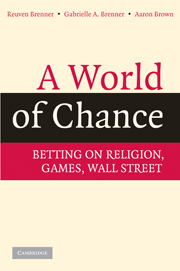Book contents
- Frontmatter
- Contents
- Preface
- Acknowledgments
- 1 From Religion to Risk Management: What to Do When Facing Uncertainty?
- 2 Anything Wrong with Gambling as a Pastime?
- 3 Are You Rich? Risk-Taking and Gambling, or the Leapfrogging Instinct
- 4 Betting on Futures and Creating Prices
- 5 Gambling as Banking: Poker, Junk Bonds, and Central Banks
- 6 Lottery Is a Taxation, and Heav'n Be Prais'd, It Is Easily Rais'd
- 7 Politics and Prohibitions; or, What's a Good Tax Anyway?
- 8 How Gamblers and Risk-Takers Correct the Future
- Appendix 1 Gambling and Risk-Taking: The Leapfrogging Instinct
- Appendix 2 Human Nature and the Civilizing Process
- Appendix 3 A Statistical Profile of Gamblers
- Notes
- Bibliography
- Name Index
- Subject Index
4 - Betting on Futures and Creating Prices
Published online by Cambridge University Press: 06 July 2010
- Frontmatter
- Contents
- Preface
- Acknowledgments
- 1 From Religion to Risk Management: What to Do When Facing Uncertainty?
- 2 Anything Wrong with Gambling as a Pastime?
- 3 Are You Rich? Risk-Taking and Gambling, or the Leapfrogging Instinct
- 4 Betting on Futures and Creating Prices
- 5 Gambling as Banking: Poker, Junk Bonds, and Central Banks
- 6 Lottery Is a Taxation, and Heav'n Be Prais'd, It Is Easily Rais'd
- 7 Politics and Prohibitions; or, What's a Good Tax Anyway?
- 8 How Gamblers and Risk-Takers Correct the Future
- Appendix 1 Gambling and Risk-Taking: The Leapfrogging Instinct
- Appendix 2 Human Nature and the Civilizing Process
- Appendix 3 A Statistical Profile of Gamblers
- Notes
- Bibliography
- Name Index
- Subject Index
Summary
Which shows how conventional wisdom about futures markets was often wrong, and the relationship between these markets and gambling and insurance.
To gamble.
To bet.
To speculate.
To invest.
All these terms and other phrases (“to take a chance,” “to challenge luck,” or “to take risks”) have been used when people put money in stocks, futures markets, and derivatives, or have bought and sold land, houses, or other tangible assets. As we saw previously, both England and the United States passed at various times in their histories laws that made contracts to wager unenforceable. The problem that often came up both before the courts and in public policy debates was how to distinguish between contracts that allocated risks and rewards legitimately in productive sectors and gambling or wagering contracts.
This chapter shows that the source of the confusion – still with us today, even in the United States and the United Kingdom, sophisticated financial markets notwithstanding – is the false idea that the “real” economy can be divorced from the financial, betting one, and still function well.
- Type
- Chapter
- Information
- A World of ChanceBetting on Religion, Games, Wall Street, pp. 67 - 89Publisher: Cambridge University PressPrint publication year: 2008



